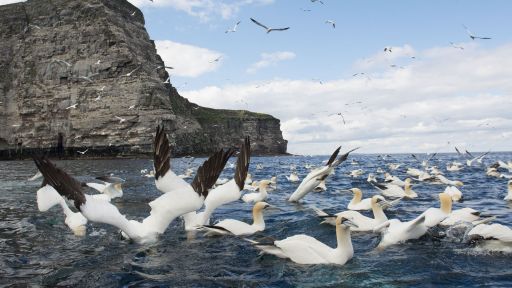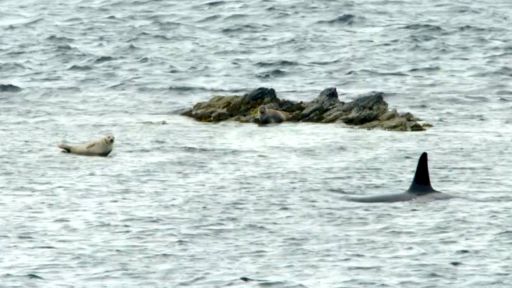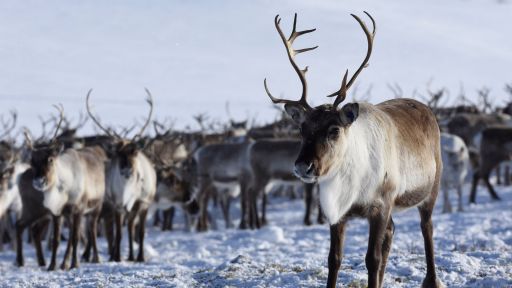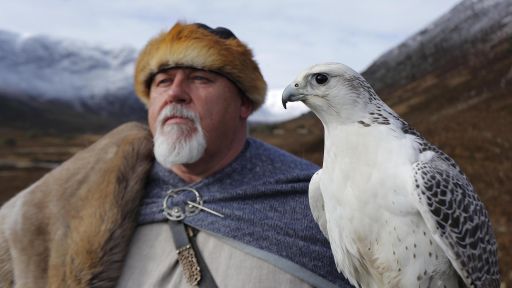Go behind the scenes with the crew to find out more about the making of this epic film. From capturing the behaviors of orcas to avoiding diving gannets, recreating the world of the Vikings was no easy task.
Features




The Wild Way of the Vikings film was by some stretch the most exciting, ambitious and ultimately rewarding project I think I've ever been involved in.
So the whole film turned into something of an essay, not only about the wildlife of the North Atlantic, but the wildlife of the North Atlantic in the Viking Age.
Without a doubt the most exciting thing to film during the Vikings project for me was was the orca. I'd been based up in Shetland for three months at that point and on my very second day in Shetland I'd seen orca from somewhere ahead. And at that point you might be thinking, ah this is great, you're gonna get all these opportunities to film the orca.
And during those 12 weeks I never saw the orca again until the very last week.
And Richard and myself, the other camera man who did the drone filming, would get up at 6 o'clock every morning and have a phone call thinking about where they'd last been seen, where we think they might be today.
When you're following the orca, even if you picked headlands to go to, they can swim past you in just a few seconds and all you get is a glimpse of them as they pass you by.
So to actually spend enough time with them to film behavior was what was going to prove to be a challenge.
On one particular day, I think was the 24th ofJuly, and we watched as the pod came in and quickly identified there was a seal on the bottom.
And we were almost in disbelief as we watched them kind of circling just over one spot knowing that somewhere down there there was a seal desperately trying to escape for its life.
You just remember this huge splash, and this is something that's maybe only been seen a few dozen times certainly only may be filmed once or twice ever before.
I think one of my favorite bits in the film is the Vikings as they move amongst the gannet colony and when you watch it, it's so dramatic and I think the actual shoot was probably just as dramatic.
The most difficult job I've ever been given as a drone operator was to fly amongst the gannets.
Naturally, I was slightly nervous, but on the positive side what we knew about gannets is that despite the fact they're very territorial at their nesting sites, actually when they're in the air they're quite passive, so the risk was minimized.
We also had spotters as well, but it wasn't to say it wasn't hairy, cause it was.
We had a drone which was like the ultimate game of Space Invaders, 3D Space Invaders.
There's a couple of times when some gannets flew really close to the lens and, yeah my heart fluttered, definitely fluttered.
They were climbing up the cliffs and we thought, 'you know they'd look so much better in barefoot,' so the two re-enactors were slightly surprised when we said, 'could you take your shoes and socks off and just scale this cliff for us, please?'
But they were pretty game and we checked in with all our health and safety crew and it looks amazing.
I think it's one of the really, really exciting shots in the film.
For these Icelandic sequences, it's in fact the the camera assistant, Steven McGhee Callendar, who appears in those Viking scenes. We asked him to grow his hair long.
Steven had to walk through an arctic tern colony. Arctic Terns are very aggressive if anything goes anywhere near their nests and they took a particular liking to Steven's rather long hair and beard.
So it felt like they were dive-bombing him to try and pluck out some of that hair and beard possibly to line their nests. Or maybe they just didn't like the look of him, I'm not sure.
So with the storm petrels, and to film that scene we were filming - you know 11:00 p.m. and 2:00 a.m. as these birds only actually returned into the nest sites under the short hours of darkness that you get in summertime.
That was a real challenge, working with low light and also obviously trying to minimize the disturbance to the birds.
Because we were camping on Mousa, it's an uninhabited island, we had to bring our own freshwater. We had no electricity, no heating.
So the conditions were probably not dissimilar to to something the Vikings would have experienced.
We heard over the radio that a storm was coming in, and true to form one of the great storms came across the Atlantic.
We're talking winds of 60 miles an hour, pouring with rain, so it proved to be a challenge to, not only film in those conditions, but it was actually quite challenging for the animals themselves.
I brought two tents with me fortunately, but both of them were actually destroyed.
My tent was the best tent! All the other crews tents blew down.
The crew, we were stuck out in the bad weather, so I think the storm petrels, to be honest, they had a better idea of how to hide away than the crew did.
I think the single most outstanding scene that we filmed was the the scene involving the Viking hunter, and the reindeer herds.
Our Viking archer, who's called Dag Inge Bakke, turned up and executed this scene, and it was just fabulous.
He had this amazing set of birchwood skis that were replicas of like a thousand-year-old Viking skis.
And these had been found at the foot of a melting glacier.
So to see this guy turn up with moose and beaver pelt boots, with that amazing Viking clothing and then the set of Birchwood skis, we instantly thought that this is combined with the reindeer would really create a spectacular sequence.
And just seeing that number of reindeer thundering around together... Natural history's kind of filled everything but that felt new and fresh.
For a project like this it really draws on the passion and work of so many people.
When we started this film, I had no idea the level of stories that would unfold as we started to dig into it.
Just the sheer resourcefulness of the Vikings and the intimate knowledge of nature has been a real eye-opener.
